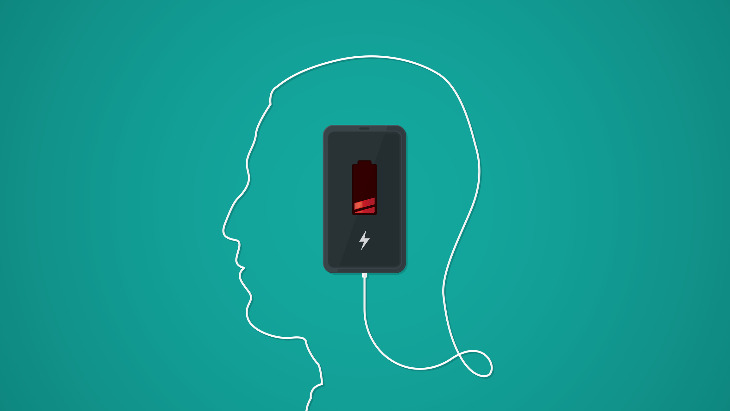 Passover’s Message of Hope in the Aftermath of Oct. 7
Passover’s Message of Hope in the Aftermath of Oct. 7


5 min read
A record number of Americans voluntarily left their jobs. The rationale most often given: burnout.
Sociologists, psychologists, economists and observers of the most recent trends of the post-pandemic generation put it high on the list of cultural phenomena that are creating massive changes in the way people view their lives, their work and their mental and physical health.
The word is burnout. Around the world, three out of five workers say they’re burned out. A 2020 U.S. study put that figure at three in four. A recent book claims that burnout afflicts an entire generation. In Can’t Even: How Millennials Became the Burnout Generation, the author, BuzzFeed News reporter Anne Helen Petersen describes herself as a “pile of embers.”
What, exactly, is burnout? The World Health Organization describes burnout syndrome in the eleventh revision of the International Classification of Diseases this way: “Extremes of activity, such as job monotony or chaos; lack of social support, either at work or in one’s personal life; and work-life imbalance. Risk factors include a heavy workload and long hours, feeling little to no control over work, and struggles with work-life balance.”
Burnout is now often referred to as the “new normal”.
Victims describe it as feeling so used up that they feel like a used battery that can no longer be recharged. Burnout is now often referred to as the “new normal” – and is frequently given as the explanation for a striking new reality for today’s younger workforce. The term “the great resignation” was coined in the spring of 2021 to take note of a record number of Americans who voluntarily left their jobs. And the trend keeps growing, especially with the younger generation.
While older generations disdained rapidly switching from job to job, it is becoming increasingly common. A recent study found that 65% of Generation Zers – those born between 1982 and 2004 – plan to stay at their jobs for less than a year, compared to 40% across generations. Generation Z, according to data from the Bureau of Labor Statistics, spends an average of two years and three months at the same company. During that time, an additional innovation often makes its presence known: “quiet quitting.” It is a personal commitment to do only as much as contractually required, both by time and by effort. And the rationale most often given for the adoption of “the great resignation” as well as the “quiet quitting” as occupational guideposts is – as you probably guessed – burnout.
There’s a striking biblical analogy to our current reality that offers a powerful insight into both the problem as well as its resolution.
Couched in the story of the selection of Moses as leader of the Jewish people, the Book of Exodus tells us the fascinating tale of the first meeting between God and Moses. God wanted Moses, a shepherd tending to his flock, to be aware of the divine presence, so He performed a miracle. Suddenly, before Moses’ eyes, was a burning bush – and yet it was not consumed. From this Moses was to recognize that it was none other than God appearing to him with the mantle of leadership.
If the purpose of the miracle was to prove God’s divinity by demonstrating His superhuman power, making a bush burn and not be consumed seems to be a rather tame illustration of God’s majesty and might. Surely God could have done better!
Contemporary burnout has a spiritual source. It’s a response rooted in lack of purpose.
There was another purpose behind the miracle. God was sending Moses a message that would serve him as a guide throughout his years of his leadership: those who dedicate their lives to divine purpose will never suffer burnout.
Contemporary burnout has a spiritual source. It reflects on the distance we’ve created between money and meaning. “The great resignation” is a response rooted in lack of purpose. The pandemic highlighted the potential for life’s brevity; it made clear that possessing more “things” that could be consumed in a moment couldn’t possibly be the key to the meaning of life.
There’s a famous parable of three bricklayers rooted in an authentic story. After the great fire of 1666 that leveled London, the world’s most famous architect, Christopher Wren, was commissioned to rebuild St Paul’s Cathedral. One day in 1671, Christopher Wren observed three bricklayers on a scaffold, one crouched, one half-standing and one standing tall, working very hard and fast.
To the first bricklayer, Christopher Wren asked the question, “What are you doing?” to which the bricklayer replied, “I’m a bricklayer. I’m working hard laying bricks to feed my family.” The second bricklayer, responded, “I’m a builder. I’m building a wall.” But the third brick layer, the most productive of the three and the future leader of the group, replied with a gleam in his eye, “I’m a cathedral builder. I’m building a great cathedral to the Almighty.”
For the first bricklayer, building the wall was a job. For the second bricklayer it was an occupation. For the third, it was a calling.
A calling reflects our universal need to matter, to influence, and make a difference in the world around us. Viktor Frankl made this clear in his book, Man’s Search for Meaning. He wrote how those who survived the Holocaust had one thing in common: they all clung to a purpose or reason to continue to live. Those who survived found some meaning in their painful circumstances.
It is the power of purpose, of infusing meaning in to our lives, that is the antidote to the contemporary debilitating disease of burnout. It was the first message God imbued Moses with to help him become the greatest Jewish leader. And it’s the message we need to counter the cynicism, depression and despair of present-day burnout.
